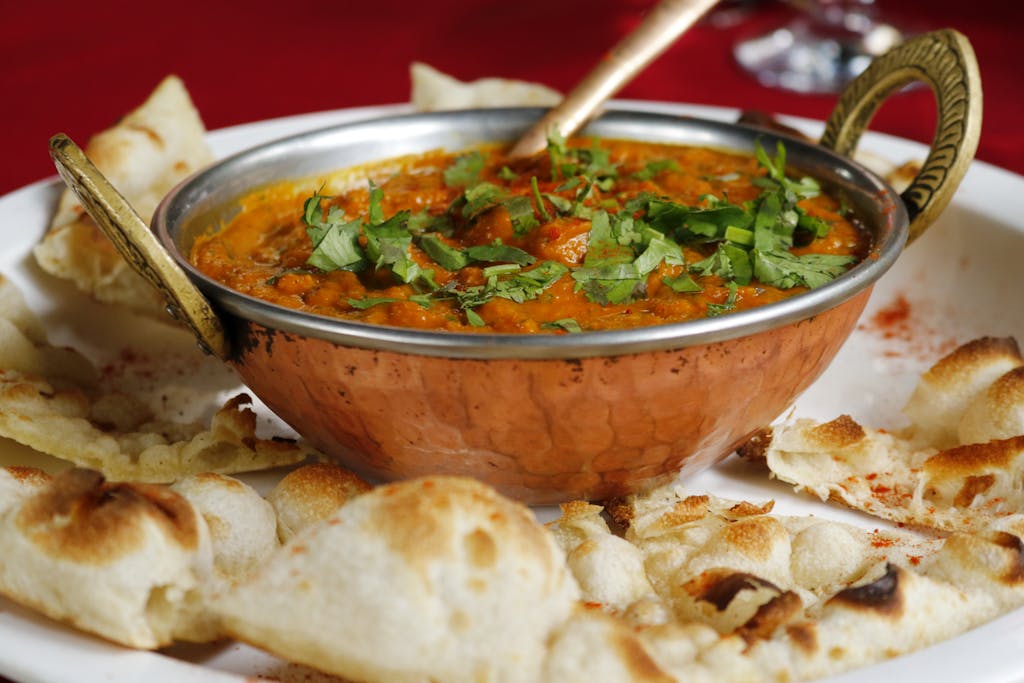If you’re craving a dish that’s both indulgent and steeped in tradition, goat korma is exactly what you need. Creamy, nutty, and perfectly spiced, it’s the kind of dish that makes every bite unforgettable. The flavors are layered in such a way that your palate experiences warmth, richness, and a subtle complexity all at once. But what makes goat korma so special, and why does it stand out from other curries? Let’s dive into this culinary delight and explore why this dish has captured hearts for centuries.

What is Goat Korma?
At its core, goat korma is a slow-cooked curry made with tender pieces of goat meat, yogurt, cream, and a carefully balanced mix of aromatic spices. Unlike fiery, hot curries that make you reach for water with every bite, korma focuses on richness and subtle flavors that linger on your tongue. Imagine a luxurious velvet suit, smooth and elegant—that’s exactly what korma feels like on your palate.
It’s creamy yet light, fragrant without being overpowering, and indulgent without feeling heavy. Korma is comfort food elevated to a gourmet level, offering a perfect combination of texture, flavor, and aroma.
Order Online
Origins of Goat Korma
Korma has a fascinating history that traces back to the Mughal era in India and Pakistan, a time when royal kitchens were all about opulence and flavor mastery. Emperors and nobles would indulge in dishes that blended meat with cream, nuts, and aromatic spices, creating a culinary experience that was as much about luxury as it was about nourishment.
Originally reserved for kings and high-ranking officials, goat korma gradually made its way into common households, retaining its rich, indulgent essence. Today, it’s enjoyed in homes and restaurants alike, celebrated as a dish that combines history, tradition, and flavor in every bite.
Why Goat Meat Works Best
Goat meat has a unique, slightly gamy flavor and a firm texture that makes it ideal for korma. Unlike chicken or beef, which can become overly soft or lack character in a creamy sauce, goat maintains its shape and absorbs the spices beautifully. Its gaminess adds depth and complexity, creating a balance that is both earthy and indulgent.
Another advantage is that goat meat is leaner than many red meats, providing a healthier option without compromising on taste or richness. The texture, flavor, and nutritional benefits all come together to make goat meat the perfect choice for this classic dish.
Key Ingredients in Goat Korma
The magic of goat korma lies in its ingredients. Each element plays a specific role in building layers of flavor, and getting them right is essential to achieving that melt-in-your-mouth experience.
Goat Meat Selection
For the best results, choose young, tender cuts such as the leg, shoulder, or loin. These cuts cook evenly and remain juicy without turning tough or stringy. Older goat meat can be used, but it requires longer, slower cooking to soften the fibers and extract the flavors fully. Fresh beef is non-negotiable—it’s the foundation upon which the entire dish relies. Tender, high-quality goat meat will allow your korma to reach its full potential.
Essential Spices
Spices are what give goat korma its signature warmth and aroma. Ground coriander, cumin, turmeric, cinnamon, cardamom, cloves, and a pinch of saffron form the backbone of this dish. Each spice adds a distinct layer—cumin brings earthiness, cardamom adds floral sweetness, cinnamon adds warmth, and cloves give a subtle pungency. The key is harmony; no spice should overpower the others. When balanced correctly, the spices elevate the meat and sauce, turning every bite into an aromatic experience.
Dairy and Nuts in Korma
Creaminess is essential in a korma, and that comes from yogurt, cream, and ground nuts like almonds or cashews. These ingredients not only create a velvety texture but also help mellow out the spices, making the curry smooth, rich, and luxurious. The nuts contribute subtle sweetness and depth, while the cream ensures every spoonful coats the meat beautifully. Without these elements, korma would lose its signature indulgence and richness.
Step-by-Step Goat Korma Preparation
Making goat korma is a labor of love, but every step is worth it for the final result. From marination to slow cooking, attention to detail ensures the flavors develop fully and the meat becomes tender.
Marinating the Goat
Marination is where the magic begins. Coat the goat pieces in a mixture of yogurt, garlic, ginger, and spices, and let them rest for at least two hours. Overnight marination is even better, as it allows the flavors to penetrate the meat deeply, tenderizing it and enhancing the overall taste. This step ensures that when you cook the meat, it will be succulent and bursting with flavor, making the effort absolutely worthwhile.
Preparing the Korma Sauce
Start by sautéing onions until they turn golden brown, releasing their natural sweetness. Add ginger, garlic, and your carefully measured spices to form a fragrant base. Slowly stir in yogurt, cream, and ground nuts, creating a sauce that is smooth, rich, and aromatic. The sauce should coat each piece of meat generously, ensuring every bite is infused with flavor. The slow addition of dairy prevents curdling and allows the spices to blend harmoniously, achieving that signature korma consistency.
Cooking Techniques for Tender Meat
The secret to tender, flavorful goat lies in slow cooking. Allow the curry to simmer gently on low heat so the meat absorbs all the spices and becomes succulent. Pressure cooking is an option if time is limited. Still, nothing beats traditional slow simmering for depth of flavor and tenderness. Patience is key—rushing this step will result in less tender meat and a sauce that lacks the full-bodied richness korma is known for.
Tips for Perfect Goat Korma
Even seasoned cooks sometimes find korma challenging. Paying attention to a few critical tips can make a world of difference.
Balancing Spices and Creaminess
Taste as you go and adjust the seasoning gradually. The sauce should be flavorful and aromatic, not overpowering. Add extra cream or nut paste if needed to soften intense spices. Striking the right balance ensures a luxurious, harmonious dish that is both indulgent and comforting.
Achieving the Right Consistency
Korma should have a velvety sauce that clings to the meat while flowing gently. If the sauce is too thick, add a splash of water or stock; if it’s too thin, reduce it slowly over low heat until creamy. Proper consistency is crucial for presentation, texture, and overall enjoyment.
Common Mistakes to Avoid
High heat can toughen the meat, and skipping the marination can result in a bland dish. Be cautious when adding cream, as overheating may cause it to curdle. Patience is essential in every step—from marinating to slow cooking—to achieve the perfect korma.
Serving Suggestions
Goat korma deserves thoughtful pairings to enhance its flavors.
Pairing Goat Korma with Rice
Steamed basmati rice or aromatic pilaf works beautifully, soaking up the sauce and making each bite rich and satisfying. Rice provides a neutral backdrop that balances the richness of the curry and allows the spices to shine.
Bread Options: Naan, Roti, and Paratha
Soft naan, buttery paratha, or simple roti are ideal for scooping the sauce. Using bread transforms the meal into an interactive experience, allowing you to enjoy every drop of the creamy, nutty curry. It’s comfort food in its most delicious form.
Accompaniments and Sides
Fresh salad, pickled vegetables, or raita provide a refreshing contrast to the richness of korma. These sides cleanse the palate, highlight the dish’s flavors, and make the meal more balanced and enjoyable.
Health Benefits of Goat Korma
Beyond indulgence, goat korma can be surprisingly nutritious.
Nutritional Value of Goat Meat
Goat meat is lean, high in protein, and lower in saturated fat than beef or lamb. It’s a healthy red meat alternative that offers robust flavor without the heaviness, making it ideal for those looking for both nutrition and taste.
Benefits of Spices and Nuts
Spices like turmeric and cardamom have anti-inflammatory and digestive benefits, while nuts provide healthy fats, vitamins, and minerals. Goat korma combines indulgence with nourishment, offering a satisfying dish that also supports wellness.
Goat Korma in Restaurants vs Home Cooking
Restaurant korma often tastes richer because of clarified butter, high heat, and longer cooking times. At home, you have control over spice levels, creaminess, and portion size, making it possible to create a version tailored exactly to your taste.
Why Restaurant Korma Tastes Different
Chefs often use ghee and cook the curry on high heat to achieve concentrated flavors and a glossy texture. This results in a sauce with intense depth, but it may be saltier or heavier than a home-cooked version.
Making It at Home for Better Flavor
Cooking goat korma at home lets you control freshness, spice intensity, and ingredient quality. With practice, your homemade korma can rival—or even surpass—the flavor and texture of restaurant versions.
Conclusion
Goat korma is more than just a meal—it’s a culinary journey. Creamy, nutty, and perfectly spiced, it celebrates tradition, flavor, and craftsmanship in every bite. Whether served at a restaurant or cooked at home, each spoonful tells a story of indulgence and history. So grab a spoon, some naan, and dive into this luxurious dish—you deserve it!
FAQs About Goat Korma
1. Can I use lamb instead of goat?
Yes, lamb works well, though goat has a firmer texture and slightly gamier flavor that makes the dish unique.
2. How long should I marinate the meat?
Marinate for 2–4 hours. Overnight marination enhances tenderness and flavor even more.
3. Is goat korma spicy?
Traditional korma is mild to medium. You can adjust chili levels to your taste preference.
4. Can I make goat korma in a pressure cooker?
Absolutely! It reduces cooking time, but slow simmering brings out deeper, more complex flavors.
5. How do I prevent the cream from curdling?
Cook on low heat and add cream or yogurt gradually while stirring constantly. Avoid high heat to maintain the silky texture.
